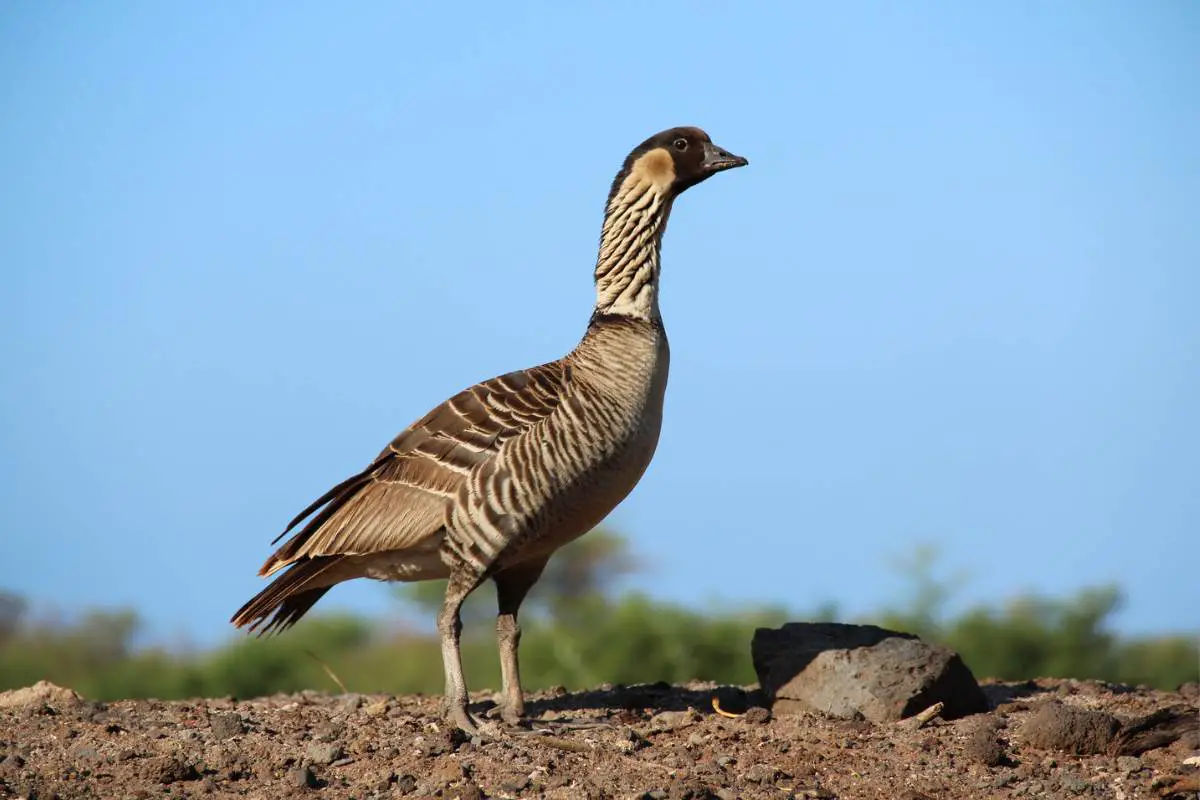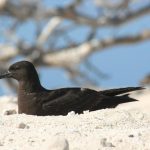Hawaii is a unique area that is known as a tropical paradise, filled with stunning flora and fauna. Its warm temperatures and beautiful blue waters make the Hawaiian islands a favorite vacation destination, and visitors to the area often remark about the diverse amount of birds they see on their trip. While you are probably aware that there are several different types of waterfowl that call the islands their home, you may be wondering if there are geese in Hawaii?
Are there geese in Hawaii?
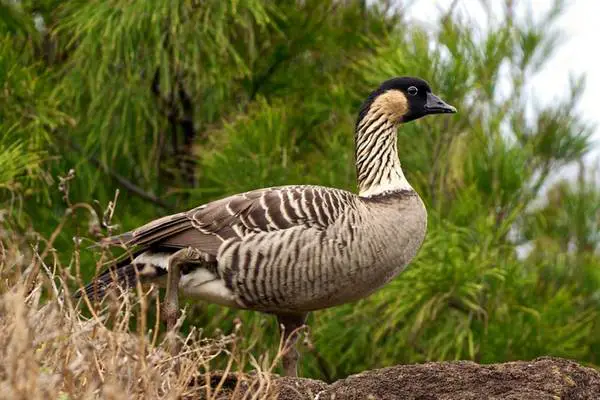
According to the Department of Land and Natural Resources of Hawaii, the islands were once home to five species of geese. However, you will now only see one species of goose in Hawaii, and that species is the Hawaiian goose (Branta sandvicensis).
Commonly known as the Nēnē, the Hawaiian goose is a medium-sized goose that measures about 25 inches long. It has webbed feet, a black head, a black bill, black legs, and black tail feathers. Its neck is furrowed and it’s body is covered in gray and brown feathers. Both the male and female of the species look similar, but the male is a little heavier and larger than the female.
Hawaiian geese mate for life and build their nests on the ground. These nests are typically shaped like a bowl and lined with down and vegetation. It is not uncommon for them to make their nests under shrubs to keep them hidden.
The geese breed from October to March, and females can lay 2 to 5 eggs. The female of the species will incubate the eggs, which typically takes about 30 days, while the male goose guards their nest. Both parents raise the goslings, and fledging of the offspring typically occurs between 10 to 12 weeks.
Where is the Hawaiian Goose found?
The Hawaiian goose is found on the following Hawaiian islands: Maui, Hawai’i, Moloka’i, O’ahu, and Kaua’i. They thrive in various habitats, including volcanic deserts, open apline woodland/shrubland areas, grasslands, and lava flows at high elevations. These geese are also sometimes found on golf courses.
The Hawaiian Goose is rare
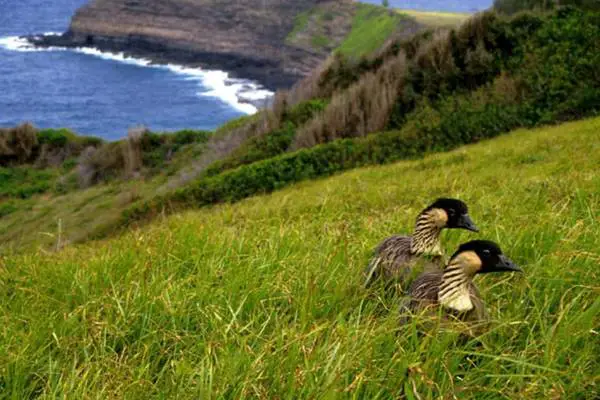
The Hawaiian goose is considered the rarest goose in the world, and it is only found in Hawaii. In fact, this species was almost extinct in the 1950s. Thankfully, local biologists have helped to rebuild the population.
The Hawaiian goose is related to the Canadian goose, but it is the only species that cannot be found in continental areas. It is theorized by some scientists that the Hawaiian goose evolved from the Canadian goose when a Canadian goose accidentally migrated to Hawaii thousands of years ago.
According to data from fws.gov, the nēnē population has seen a significant increase since 1951 when it was estimated to be a mere 30 geese across the islands. As of 2019, the population was estimated at 3,252, reflecting a steady growth trend. Today, it is believed that the number of nēnē geese has likely approached the 3500 mark.
These geese are Hawaii’s state bird
In 1957, the Hawaiian goose became the official state bird. This species of goose seldom swims, but does have longer toes to help it climb rocky areas. Additionally, the Hawaiian goose doesn’t fly much because it has weaker wings than other goose species.
There was once a Giant Hawaiian Goose
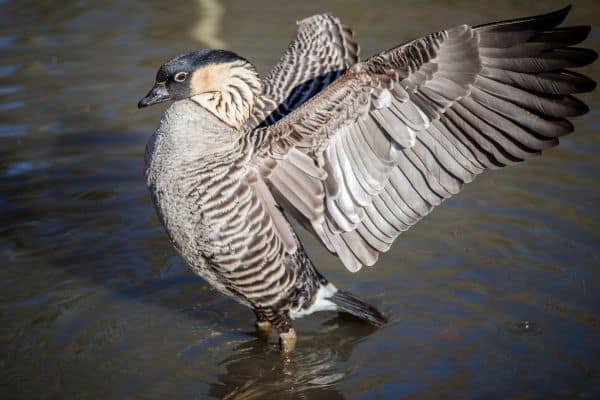
Years ago, there was a prehistoric species of goose in Hawaii known as the Giant Hawaiian goose (Branta hylobadistes). It was almost four feet tall and weighed about 4 times the size of the current Hawaiian goose. However, this species has been extinct for some time.
What does this goose eat?
The Hawaiian goose is a herbivore, and mainly feeds on seeds and leaves of various native and non-native grasses and sedges. But they will also consume fruits and flowers as well.
It is not uncommon for these geese to follow cattle around farms, looking to consume the grass shoots that the cows leave behind. As for hydration, Hawaiian geese don’t require much fresh water since they have adapted to receiving their water needs through the berries and grasses they consume.
What is the lifespan of The Hawaiian Goose?
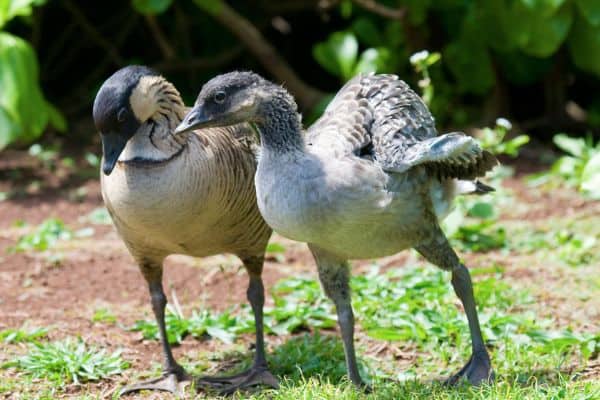
These geese can live for up to 24 years when in captivity. Unfortunately, their lifespan is reduced in the wild. In fact, they can live for only a few years in the wild, thanks to many different factors.
Why are Hawaiian Geese declining?
Hawaiian geese are listed as threatened and are actually the 6th most endangered waterfowl species in the world, according to Ducks Unlimited. Their decline can be attributed to egg collection, hunting, and predators, such as dogs, cats, pigs, rats, and mongoose. Additionally, habitat loss plays another critical role in endangering this goose species.
Thankfully, Hawaii is working hard to prevent these beloved geese from becoming extinct. In fact, Hawaii started captive breeding programs all the way back in 1949 to help increase this species’ population.
Additionally, the Hawaiian goose became a protected species in 1967. Thankfully, they have been able to grow this species’ population enough that it is not listed as being critically in danger of extinction.
That doesn’t mean, however, that the work to protect this species is done. The sad truth is that the Hawaiian goose is still listed as a near threatened species, which means it has the potential to become extinct in the near future.
